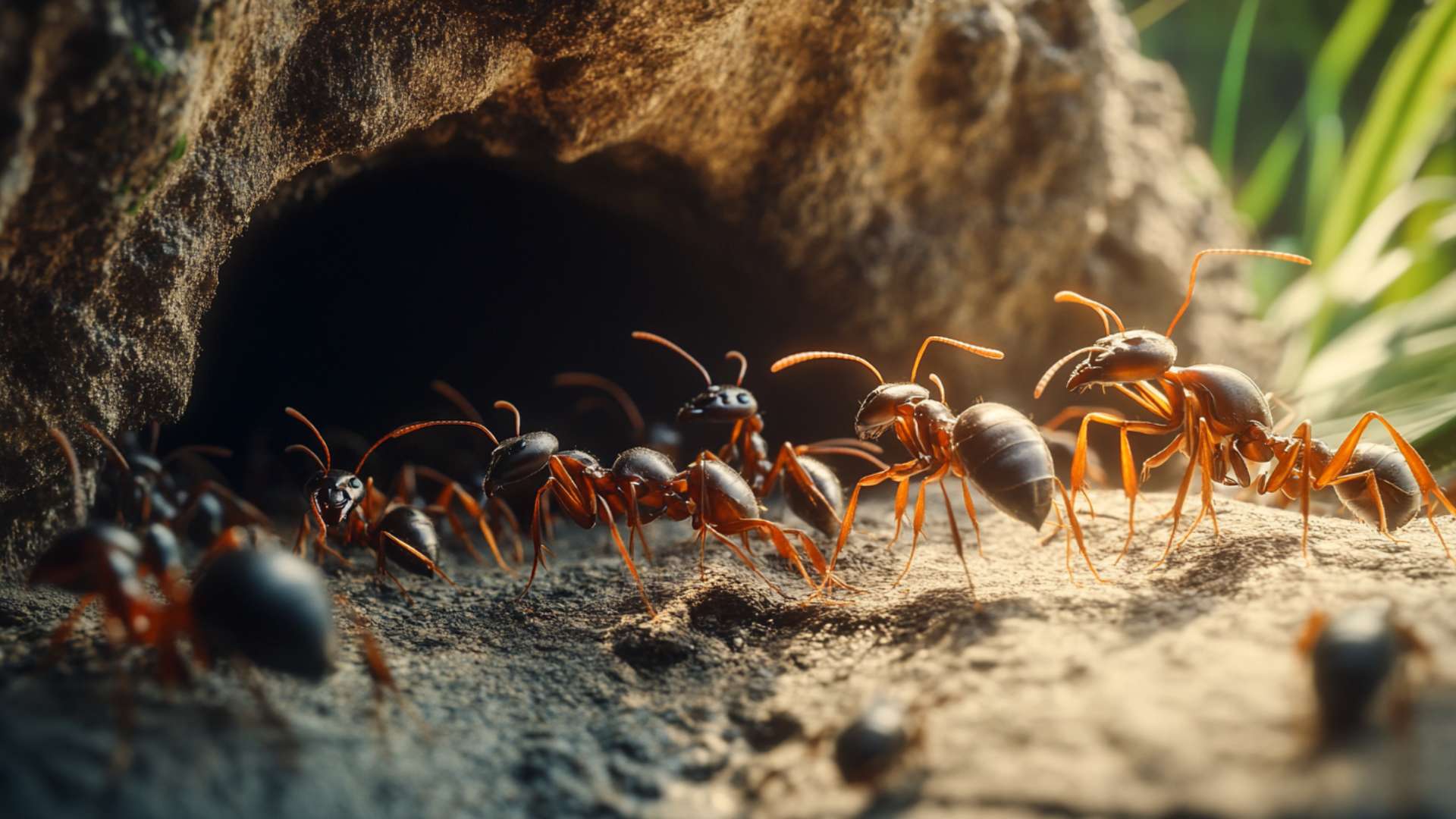Big black ants in Las Vegas are a common sight, scurrying across the pavements and through our yards. These intriguing insects belong to various species, with one of the most prevalent being Camponotus pennsylvanicus.
While they may seem like insignificant creatures, understanding their behavior and characteristics is of utmost importance. By delving into the world of these big black ants, we can gain insights into their habits, mitigate potential damage they may cause, and coexist peacefully within our environment.
Overview of the big black ants in Las Vegas
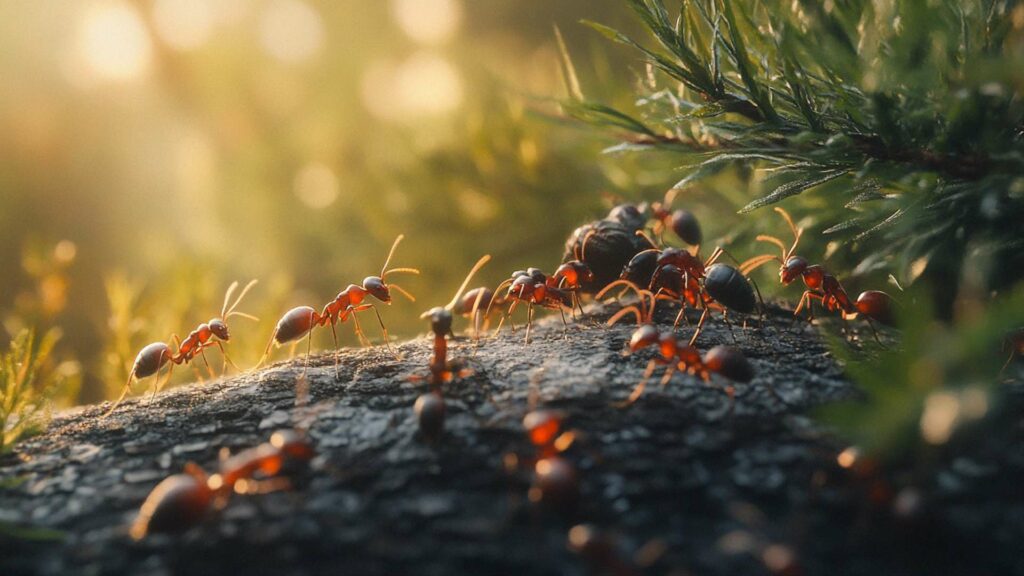
The big black ants found in Las Vegas are primarily known as the carpenter ant nest or ants. These large insects can range in size from 5 to 14 millimeters and are distinguished by their dark coloration. Unlike termites that feed on wood, carpenter ants do not eat it; instead, they excavate tunnels within decaying wood or other available sources to build nests.
This is why they are often encountered near trees, wooden structures, or even inside homes. Camponotus pennsylvanicus is a familiar species of carpenter ant found in Las Vegas.
They have shiny black bodies with reddish-brown legs and are capable of inflicting a painful bite if provoked. The workers diligently forage for food while the queen’s primary role revolves around reproduction and laying eggs.
Importance of understanding their behavior and characteristics
Why should we bother studying these seemingly harmless creatures? Well, for starters, carpenter ant infestations can lead to serious damage if left unchecked.
These industrious creatures excavate smooth tunnels through wood material to create nests where they raise their young ones. Over time, this activity weakens structures such as decks or wooden furniture.
Furthermore, by understanding the behavior patterns of big black ants, we can take necessary precautions to minimize potential problems. Knowing how they communicate, forage for food, and build their nests can help us identify signs of an infestation early on.
For instance, the presence of wood shavings near wooden structures or mature larvae could be a sure sign that carpenter ants have set up shop. By gaining knowledge about the big black ants in Las Vegas, we can coexist with these creatures while ensuring the protection of our homes and surroundings.
It’s essential to recognize their significance and appreciate the intricacies of their existence. So, let’s dive deeper into their world and explore the fascinating behavior and characteristics of these ants roaming our desert city.
Species of Big Black Ants in Las Vegas
Common Species Found in the Region (e.g., Camponotus pennsylvanicus)
In Las Vegas, one of the most common species of big black ants is Camponotus pennsylvanicus, commonly known as the carpenter ant. These ants are robust and can grow up to half an inch long.
They have a glossy black exoskeleton and a heart-shaped abdomen. Carpenter ants are notorious for their ability to excavate tunnels in various wood sources, which often leads them to become pests in homes or other structures.
They do not eat wood like termites; instead, they tunnel through it to create nest galleries and satellite colonies. These colonies usually consist of workers and sometimes include mature larvae that assist in the parent colony for maintenance.
Unique Features and Physical Characteristics
Apart from their large size and their dark brown coloration, carpenter ants possess several unique features and physical characteristics that set them apart from other ants found in Las Vegas. One interesting trait is their ability to emit a distinct sound by rubbing their mandibles together when threatened or disturbed.
Additionally, carpenter ants have well-developed jaws called mandibles that they use for various purposes like excavating wood and defending their territory. Their antennae are elbowed, providing them with an excellent sense of touch and smell, which aids in communication with other members of the colony.
It’s worth noting that while carpenter ant control) ants may resemble other black ant species at first glance, they can be distinguished by observing their behavior around wooden structures or identifying nesting areas within wall voids, decayed wood, or even tree stumps. By understanding the common species of big black ants found in Las Vegas like Camponotus pennsylvanicus (carpenter ant) and recognizing their unique physical attributes, we become better equipped to identify and deal with any potential carpenter ant infestations that may occur in our homes or surroundings.
Habitat and Nesting Habits
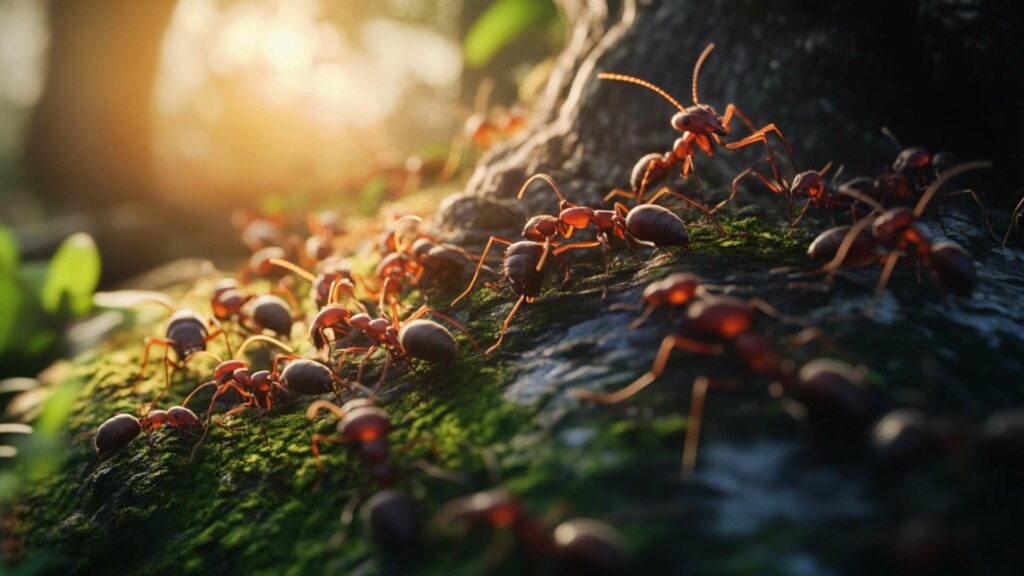
Preferred Habitats: Desert Landscapes, Gardens, and Homes
Big black ants in Las Vegas have a knack for adapting to various habitats, but they are particularly fond of desert landscapes, gardens, and even our homes. These resourceful creatures can build their nests in a variety of locations within these environments.
When it comes to desert landscapes, you may find them constructing their nests amidst rocks or underneath cactus patches. In gardens, they often choose secluded spots near plants or beneath decaying tree limbs.
However, the ants’ audacity doesn’t stop there – they are known to infiltrate our very own homes as well. One common place where you may encounter these industrious insects indoors is inside walls or in hollow doors.
Similar to termites, big black ants have an affinity for moist areas and decayed wood and can cause structural damage if left unchecked. So be aware of any soft spots or warped surfaces as it could be a sure sign that these little invaders have set up camp.
Nesting Patterns and Locations: Underground Hideouts and Tree Stumps
When it comes to nesting patterns and locations, big black ants exhibit remarkable ingenuity. Outdoors, they tend to build their nests underground – sometimes hidden beneath piles of debris or nestled within cracks in pavement.
These subterranean colonies consist of intricate tunnel systems which the ants create by excavating soil and other materials. Tree stumps also serve as favored nesting spots for these relentless creatures.
The soft inner layers of decaying wood offer an ideal environment for carpenter ant colonies seeking shelter from the elements. If you hear a faint rustling sound coming from a nearby tree stump or notice small openings on its surface resembling smooth tunnels, chances are you’ve stumbled upon one such colony.
Understanding the habitat preferences and nesting habits of big black ants is crucial for effectively managing or preventing infestations. By being aware of the environments these ants are drawn to, we can take appropriate measures to minimize their impact on our homes and gardens while ensuring the preservation of Las Vegas’ diverse ecosystem.
Behavior and Social Structure

Division of Labor within Ant Colonies (e.g., worker ants, queen)
Within the colonies of big black ants in Las Vegas, a highly efficient division of labor exists that ensures the smooth functioning and survival of the community. Each ant has a specific role to play, with different tasks and responsibilities assigned according to their caste.
Worker ants form the largest group in the colony and are responsible for gathering food, expanding the nest, caring for larvae, and defending against potential threats. These diligent workers tirelessly venture out in search of food sources and bring back provisions to sustain their fellow colony members.
At the helm of every big black ant colony is the queen. She holds a position of utmost importance as she is responsible for reproduction and ensuring the growth of the colony.
The queen produces eggs which hatch into larvae that eventually develop into worker ants or future queens themselves. Remarkably, some big black ant queens can live for several years, continuously laying eggs to maintain a constant population within their colonies.
Communication Methods (e.g., pheromones, antennation)
Communication plays an integral role within big black ant colonies as it facilitates collective decision-making and coordination among individuals. Pheromones are chemical signals released by ants that transmit messages to other members of their colony. These chemicals convey information about various aspects such as food sources, danger alerts, or marking trails for navigation purposes.
By following these trails laid out by pheromones left behind by other ants, they efficiently navigate through their surroundings. Another intriguing communication behavior observed in big black ants is antennation.
This involves touching each other’s antennae to exchange information using tactile cues. Through this interaction, ants can recognize one another as members of their own colony while also conveying important messages about potential threats or available resources.
Understanding these intricate behaviors and communication methods offers valuable insights into the social dynamics of big black ant colonies in Las Vegas. By comprehending how they function and interact, it becomes easier to appreciate the complex organization and resilience of these fascinating creatures.
Diet and Foraging Habits

Food Preferences
Big black ants in Las Vegas have a diverse palate when it comes to their food preferences. These creatures are not picky eaters and will consume a variety of items to sustain themselves.
One of their preferred food sources is sugary substances, such as nectar from flowers or honeydew produced by aphids. They are often attracted to spilled sugary drinks or leftovers in outdoor eating areas.
In addition to their sweet tooth, big black ants also feast on insects that they come across. They are skilled hunters and will actively search for small insects like flies, caterpillars, and even dead insects.
These hunting expeditions help them gather protein-rich meals, which are essential for the growth and development of their colonies. Furthermore, plant matter is also part of the big black ant’s diet.
They may nibble on fruits that have fallen from trees or gather seeds for consumption. This flexible approach to feeding allows them to adapt their diet based on the availability of resources in their surroundings.
Foraging Strategies and Patterns
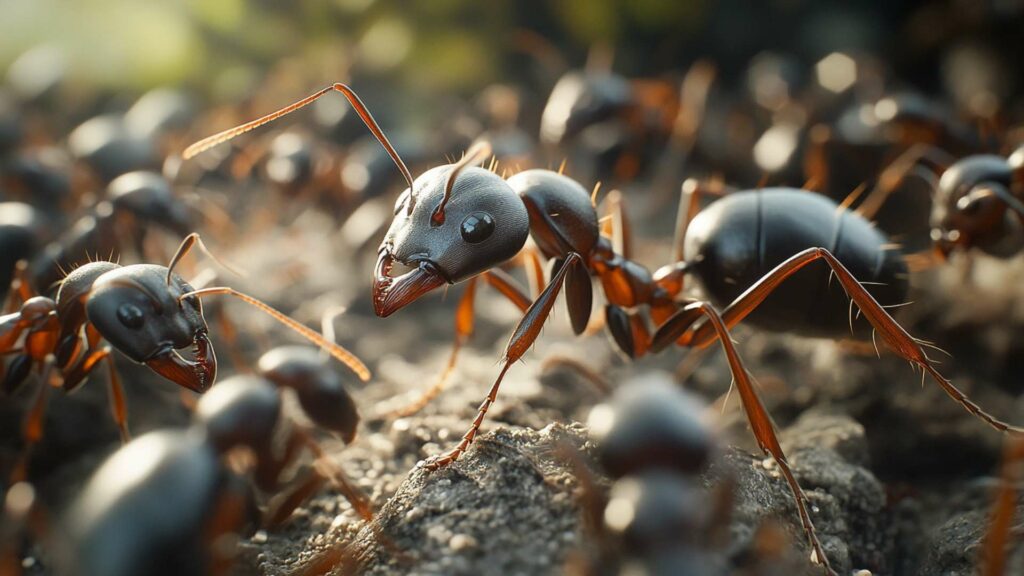
Big black ants employ various foraging strategies to efficiently locate food sources within their environment. They communicate using chemical trails called pheromones, which guide them towards potential food source locations. This communication method enables them to establish efficient routes between the nest and food sources.
When searching for sustenance, big black ants typically follow established trails created by worker ants who have previously found food. These trails can extend over large distances as worker ants venture out in search of nourishment.
Forager ants may fan out from the main trail, exploring nearby areas for potential resources. Once a successful discovery is made, they leave behind pheromone cues along the route back to the parent nest, so that other colony members can quickly find the source of food.
In times when resources become scarce or during the summer months when food demand is high, big black ants may expand their foraging range to new areas. This expansion is driven by the needs of their growing colonies and ensures their survival in challenging times.
Overall, big black ants exhibit impressive adaptability in their diet and employ resourceful foraging strategies, allowing them to thrive in the diverse environments of Las Vegas.
Interactions with humans
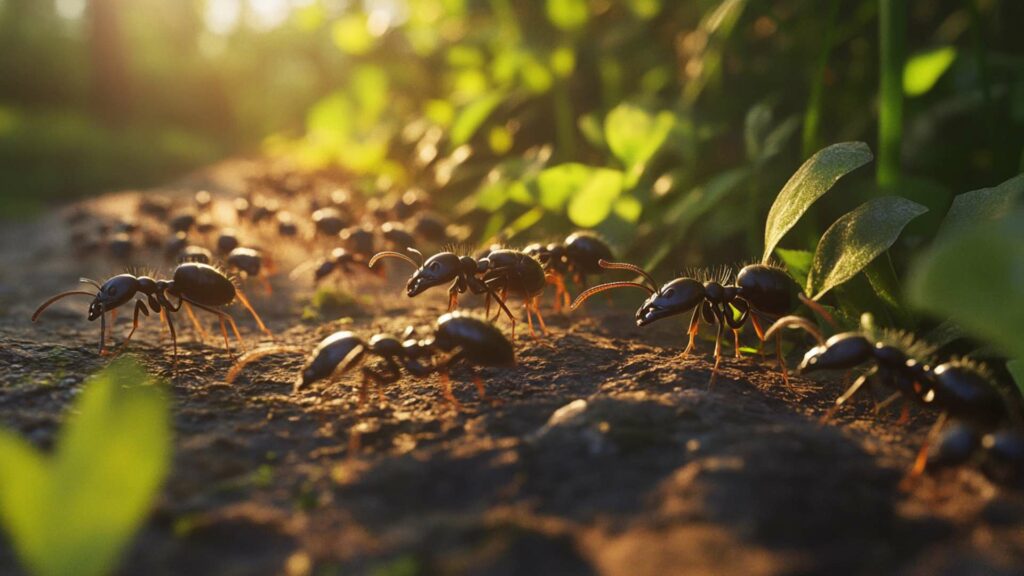
Potential damage caused by big black ants:
Big black ants, specifically the carpenter ants commonly found in Las Vegas, can cause significant damage to structures. These ants do not actually eat wood like termites do, but they excavate tunnels and galleries within it to build their nests.
As a result, they can weaken the structural integrity of buildings over time. If left untreated, carpenter ant infestations can lead to costly repairs ranging from damaged wood sources to hollow doors and even compromised wall voids.
Pest control methods to manage infestations:
When dealing with a big black carpenter ant infestation in Las Vegas, it is crucial to take prompt action. While there are DIY methods available for eliminating these pests, seeking professional assistance from a licensed pest control professional is often the best course of action. These experts have the knowledge and experience to effectively identify and target carpenter ant nests.
To manage an infestation, a licensed pest control professional may employ various tactics tailored to the specific situation. They will conduct a thorough inspection of your property to locate nests outdoors or indoors where ants gain easy access.
Treatment options typically involve using targeted insecticides applied directly into entry points or areas where ants are active. In some cases, baiting techniques may be employed using toxic baits that worker ants bring back to their colonies.
Furthermore, prevention is key when it comes to avoiding future encounters with big black ants. It is essential to address any water leaks promptly and eliminate standing water around your property as these provide attractive environments for these pests.
Additionally, regular inspections should be conducted around your house for decayed wood or other potential nesting sites that might attract these meticulous scavengers. By taking proactive measures and enlisting professional help if needed, homeowners in Las Vegas can keep their homes safe from potential damage caused by big black ants while ensuring a harmonious coexistence with nature.
Interesting Facts About Big Black Ants in Las Vegas
Unique Adaptations for Survival in Desert Environments
One remarkable aspect of the big black ants found in Las Vegas is their ability to adapt and thrive in the desert environment. These resilient creatures have developed several unique adaptations that allow them to survive and flourish where other species struggle.
One such adaptation is their ability to conserve water. Las Vegas, with its scorching temperatures and limited water sources, poses a significant challenge for all living organisms.
However, big black ants have a remarkable way of managing this issue. Their exoskeletons are designed to minimize water loss through evaporation, enabling them to withstand the arid conditions more effectively than many other insects.
Another fascinating adaptation is their nesting behavior. These ants have evolved specialized nest-building techniques that protect them from extreme temperatures prevalent in the desert landscape.
Rather than constructing nests on the ground exposed to direct sunlight, they often choose cooler areas such as underground burrows or shady spots under rocks or vegetation. This strategic decision helps regulate the internal temperature within their nests, providing a more comfortable environment for the colony.
Fascinating Behaviors Observed During Mating Season

During mating season, big black ants exhibit captivating behaviors that showcase intricate social dynamics within their colonies. The process begins with winged male and female reproductive ants leaving their respective colonies in search of potential mates. This phenomenon often occurs after heavy rainfall as increased moisture prompts these reproductive individuals to embark on nuptial flights.
Once outside their nests, the males release pheromones into the air to communicate their availability for mating. In response, females release pheromones indicating receptiveness and attracting males from satellite nests and other colonies as well.
This chemical communication allows genetically diverse individuals from various ant colonies to come together for successful mating. The actual mating event takes place mid-air when compatible partners find each other.
After mating, the male ants die, while the fertilized females shed their wings and begin searching for suitable nest locations to establish new colonies. This unique mating behavior not only ensures genetic diversity within the ant population but also highlights the fascinating intricacies of their reproductive strategies.
By understanding these remarkable adaptations and behaviors of big black ants in Las Vegas, we can gain a deeper appreciation for their resilience and complexity. These creatures exemplify nature’s ability to adapt to even the harshest environments, showcasing incredible feats of survival and reproductive strategies that ensure their continued existence in the desert landscape.
Conclusion
Recap of key points discussed throughout the outline
Throughout this article, we have delved into the intriguing world of the big black ants in Las Vegas. We started by providing an overview of these fascinating creatures and emphasized the importance of understanding their behavior and characteristics.
We then explored different species commonly found in the region, highlighting their unique features and physical characteristics. Moving on, we examined their habitat preferences, nesting habits, and social structure to gain a deeper understanding of their lives.
Additionally, we discussed their diet preferences and foraging strategies, shedding light on how they interact with their environment. We touched upon the interactions between big black ants and humans, focusing on potential damage caused by infestations and pest control methods.
Encouragement to appreciate the complexity and significance of these creatures
As we conclude this discussion on big black ants in Las Vegas, it is crucial to appreciate the complexity and significance of these remarkable insects. Through their tireless efforts in building nests underground or within decaying wood sources such as tree limbs, they create large colonies that exhibit exceptional social structures. The workers diligently carry out various tasks while communicating through pheromones and antennation.
Despite some instances where they may cause structural damage or become unwanted pests in our homes or gardens, it is essential to remember that most ants play vital roles in ecosystems by controlling populations of other insects or aiding in decomposition processes. Their ability to adapt to desert environments showcases their remarkable resilience.
So next time you notice a rustling sound near a ground nest or spot these common ants marching along with purposeful determination, take a moment to observe them with newfound appreciation for their intricate lives. These tiny creatures are indeed nature’s architects who deserve recognition for contributing to our world in ways often unseen by our naked eyes.
Dissuade Ants with D-Termination: Las Vegas’ Leading Pest Control Service!

If you’re dealing with ant challenges, D-Termination is here to help. Our experienced team excels at discouraging ants, rejuvenating cleanliness, and preserving the integrity of your surroundings. Bid farewell to ants—opt for D-Termination for effective pest control today!
Get in touch with us at 702-919-6310 or visit dtermination.com to schedule your ant control service and regain your space from these unwanted pests.
Frequently Asked Questions:
Sudden appearances of large black ants may be due to foraging for food or water sources.
Carpenter ants are often larger and have a different body shape compared to other big black ants.
Identifying the specific species of large black ants would require a closer examination.
Large black ants can be considered a nuisance, but they are generally not harmful to humans.

